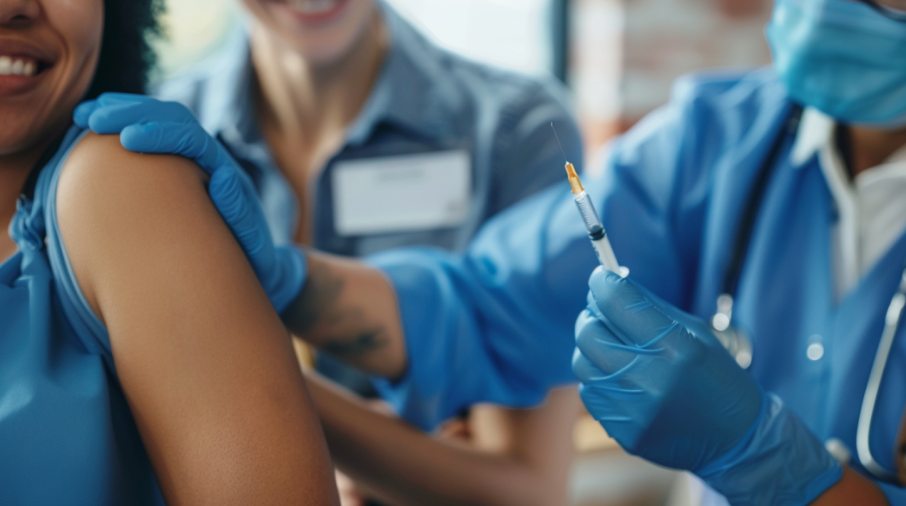Vaccine trials have a significant impact on almost every member of the population. The vaccines we received as children, for example, were first tested in clinical studies to make sure they were safe and effective. Plus studies for vaccines against diseases such as COVID-19 are playing a vital role in the world today.
It’s important to understand the different aspects of vaccine trials – including the timescales and what each phase involves – so you can make an informed decision about taking part in a vaccine clinical trial.

Looking to participate in a clinical trial? Don't know where to start?
Our clinical trial platform can connect you with trials that match your needs and eligibility. Take the first step towards accessing cutting-edge treatments and start your search today to discover the potential benefits of participating in clinical trials.
How do vaccines work?
Vaccines work by impersonating the virus or bacteria that causes a specific disease, with the aim of triggering an immune response in the body that can fight it off.
Until recently, vaccines contained inactive or weakened elements of the organism – otherwise known as the antigen. However, modern vaccines contain a blueprint of the organism rather than the actual antigen itself.
How long do vaccine trials last?
The average length of clinical trials for vaccines is five to ten years, enabling the study to go through all of the clinical trial phases. This allows time for scientists to determine whether the vaccine is safe and effective, gain regulatory approval, and manufacture the vaccine for distribution.
However, the time period between identifying the cause of a disease and the vaccine reaching the public can take anywhere from 10 to 20 years. There are also some exceptions, such as the malaria vaccine for which research has been ongoing for more than 30 years.
How are vaccine trials typically designed?
Vaccines are usually tested in double-blind, placebo-controlled, randomized trials. This means participants are randomly selected to receive either a placebo or the experimental vaccine. This also means that neither the participants nor researchers know who received the actual vaccine, which vastly reduces bias.
What are the phases of vaccine clinical trials?
Vaccines go through several development stages – known as clinical trial phases – and follow a similar process to other medical research studies. Although vaccine trials can be a lengthy process, each phase lasts a different amount of time, and participants may only need to take part in a relatively short part of the overall study.
Research and discovery
Before a vaccine can be created, scientists need to understand how the virus works, its composition, and how it impacts the body. They then develop the rationale for the new vaccine and create it in a lab.
How long does discovery take?
On average, this process takes between three to six years. However, new technologies are enabling scientists to understand the genetics of certain viruses and share this knowledge on a global scale much faster. In the case of the COVID-19 virus, this took just weeks.
Who is involved in the discovery phase?
This phase usually involves scientists and researchers. No participants are involved as the vaccine is still being developed.
Pre-clinical testing
The pre-clinical testing, or ‘proof of concept’ stage tests the vaccine on animals, assessing its ability to create an immune response, as well as its safety at all possible dosage levels. This enables scientists to make any necessary adjustments before it’s tested on humans.
Once the scientists are satisfied that the vaccine is safe to test on humans, they submit an investigational new drug application to the Food and Drug Administration (FDA) before moving on to clinical trials.
How long does pre-clinical testing take?
The pre-clinical testing phase can last anywhere between one to ten years depending on the requirements of the study, and the vaccine being assessed.
Who is involved in pre-clinical testing?
This phase typically involves scientists, researchers, and animals. No human participants are involved at this stage.
Phase I vaccine clinical trials
Phase I clinical trials allow vaccines to be tested on a relatively small group of healthy, human participants. During this phase, the vaccine is administered to some people, and a placebo is given to others. The participants are observed and tested to assess their immune response and any side effects. If necessary, a different dose of the vaccine might also be tested on a subgroup, provided it’s safe to do so.
How long is phase I of a vaccine trial?
This is one of the shortest clinical trial phases, with studies generally taking several months to complete, and rarely lasting longer than a year.
Who is involved in phase I of a vaccine trial?
Phase I vaccine trials typically involve between 20 to 100 participants, alongside a team of scientists and researchers.
Phase II vaccine clinical trials
Once phase I is completed and the researchers have determined the vaccine works, the study can move on to a phase II clinical trial. This enables them to gather more data about safety and effectiveness in a larger group of people.
How long is phase II of a vaccine trial?
Depending on the study’s requirements and how much data needs to be collected, phase II trials can last anywhere from three months to two years. If phases I and II are combined into one study, these timescales can often be shortened.
Who is involved in phase II of a vaccine trial?
Between 100 to 300 participants typically take part in phase II vaccine trials. They often share some of the same characteristics as the people the vaccine was intended for. Alternatively, they might be more diverse and inclusive trials, ensuring a more accurate representation of the broader population.
Phase III vaccine clinical trials
Phase III trials continue to monitor the short and long-term safety and effectiveness of a vaccine, assessing how well it works, and monitoring any side effects or serious adverse events. However, a much larger number of people will take part than in previous phases.
When this phase is finished, the researchers will submit the findings to the FDA for regulatory review in the hope the vaccine will be approved for general use.
How long is phase III of a vaccine trial?
This is the longest clinical trial phase and it can take many years to complete. This is because there’s a far larger group to monitor and assess, and the researchers need to determine the longer-term impacts of the vaccine.
Who is involved in phase III of a vaccine trial?
Thousands of participants usually take part in phase III vaccine trials. During this phase, the targeted virus must be actively circulating among participants to assess the vaccine's efficacy in protecting against the virus or disease.
Testing on this many people enables data to be continuously collected on a massive scale, providing even more insights into its effectiveness and safety. It also allows scientists to compare results in people who received the vaccine against those who didn’t.
Phase IV vaccine clinical trials - regulatory approval process
Any new drug or vaccine must go through a regulatory approval process with the relevant authority, and in the USA this is the FDA. Once the FDA ‘licenses’ a vaccine for use by the wider population, it will often proceed to a phase IV or ‘post-marketing surveillance’ phase involving thousands of volunteers.
This phase of the trial enables researchers to monitor the vaccine after it reaches the general public, enabling them to assess it in a large group of people in a real-world setting.
Along with collecting data about vaccine use and long-term immunity, they also assess any long-term adverse effects. If such a reaction is identified, it is reported to the Vaccine Adverse Event Reporting System (VAERS) and if concerns about the vaccine's safety are upheld, it may be withdrawn from the market. Healthcare professionals and members of the public can also report adverse effects to VAERS directly.
How long is phase IV of a vaccine trial?
This phase will often last for several years to give researchers a better picture of the long-term safety of the vaccine. Some phase IV trials may continue indefinitely as new discoveries emerge.
Who is involved in phase IV of a vaccine trial?
Phase IV vaccine trials usually include thousands of people, including those monitored in the earlier phases.
Can vaccine clinical phases be combined?
Researchers sometimes combine clinical trial phases to accelerate the time it takes for a vaccine to be developed and approved.
This was the case in many COVID-19 vaccine trials, with studies combining phases I, II, and/or III, and research beginning by administering the vaccine to a small group of healthy participants. If the vaccine appeared to be safe, more participants were added to the trials, including those with pre-existing health conditions.
However, this was a unique reaction to a global emergency, and many people question whether completing vaccine trials so quickly can ultimately be safe.
How long were the clinical trials for the COVID-19 vaccine?
Prior to COVID-19, taking a new vaccine from the concept to the approval stage could often take 10 or more years and cost billions of dollars.
The pandemic, however, placed unprecedented pressure on global healthcare systems and economies. As such, the US Department of Health & Human Services launched ‘Operation Warp Speed’ to accelerate the production of a COVID-19 vaccine. Clinical trials for the Pfizer/BioNTech vaccine took just eight months, with Moderna and AstraZeneca vaccines following similar timescales.
Conclusion
In general, clinical trials for vaccines can take anywhere between five to twenty years, with some taking even longer.
However, the phases that involve human participants can be completed in significantly less time, with phase I trials lasting several months to a year, phase II and III trials lasting several years, and some phase IV trials can even last indefinitely.
The importance of clinical trials cannot be underestimated, as they lead to innovative medical discoveries that can alter people’s lives. Vaccine trials can impact millions of people across the globe, especially during times of crisis such as a global pandemic.
Companies such as Pfizer and Moderna are currently recruiting for vaccine trials for COVID-19, flu, Respiratory syncytial virus (RSV), and shingles amongst other conditions. You can make a difference by participating in a vaccine trial, and helping scientists to protect more of the population against these infectious diseases.
FAQs
What side effects can I expect from an investigational vaccine?
Common short-term side effects include injection-site soreness, tiredness, or generally feeling unwell. Any other anticipated side effects will be communicated to you before the trial begins, and sometimes as the trial progresses.
What risks do vaccines pose?
All medical interventions present some degree of risk, and vaccines are no exception. In very rare cases around one in 100,000, people may experience a severe allergic reaction.
How are vaccines licensed?
Before a vaccine can be licensed, clinicians and scientists examine the data gathered from the pre-clinical studies, clinical trials, manufacturing process, and quality control assessments. They must also be satisfied with the supply and distribution mechanisms.
How are vaccines monitored?
Vaccines are monitored long after they are licensed, so manufacturers can continually assess their safety and effectiveness, and explore other potential uses. If they find any undiscovered side effects, they report them to the MHRA, health professionals, and the patients the vaccines were given to.
